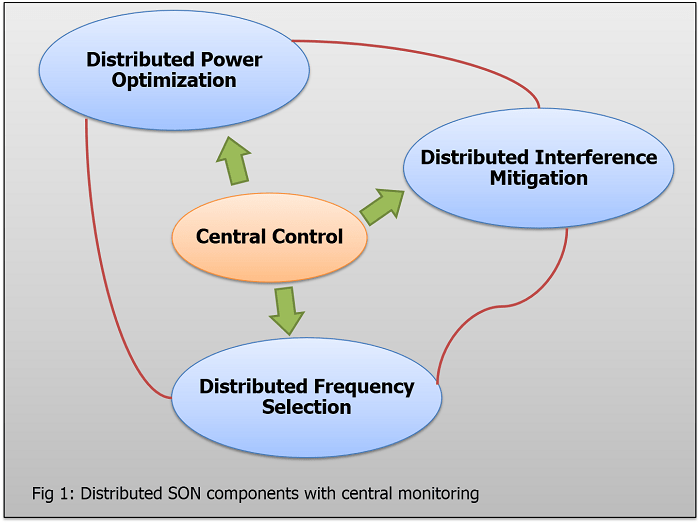Self-Optimizing Networks (SON) in cellular networks have evolved from a concept to a vital component of modern day HetNets. Major cellular vendors have built and are busy deploying SON solutions as a key differentiator for their network offerings. On the Wireless LAN side, SON implementations have been around for more than 5 years as part of the Wireless Network Management solutions offered by different Access Point manufacturers.
However, the development of SON as a network function has been anything but linear; there has been considerable back-and-forth both on the scope of what it covers as well as the way in which it is deployed. Many OEMs initially chose to see it as an add-on to the existing network management function, providing incremental benefits to an existing network. Realizations also followed the strictly centralized approach, with a SON server acting as a top level resource allocation and network tuning function.
The HSC Approach
HSC has been working on SON technologies for the last 5 years. As opposed to the trend, our approach was based on the following three principles:
- Distributed control based on direct sensing
- Embedding of SON directly within the network nodes and functional autonomy at the edge
- Emphasis on adaptability and operation based on local data
We shall discuss each of these in turn. Our first principle is based on our work in the IP domain, specifically TCP and its vastly successful congestion control protocol. TCP congestion control protocol works because it is resource hunting, while simultaneously being “respectful”; the latter principle in the TCP community being indicative of a willingness to ‘play fair’. TCP state machines constantly monitor the network state and infer dynamic network states, based on continuous sensing of very basic network information. This is one of the secrets of TCP’s success; the fact that it depends on very fundamental information i.e. packet drops.
The second principle is associated with the first and is based on our preference of simple distributed control algorithms using basic local information as opposed to centralized algorithms. Distributed control algorithms are greatly adaptive to local and global network conditions, have more predictable fail-safe behaviour and are more robust in actual deployment. While there was a time when centralized algorithms were simpler to manage, the availability of higher power CPUs in edge devices and innovative visualization and sampling techniques allow easy monitoring and testing of large scale distributed solutions.
Finally, the last principle refers to the nature of the network equilibrium that we are trying to establish. We consider SON to be a dynamic optimization problem, where the network and inter-node relationships are always volatile. Hence, one of the first decisions that we took was to get rid of static global configuration data, such as Neighbour Relation configurations; in all our algorithms model the optimization problem as that of the node against the ‘network’ where the ‘network’ represents the mass effect of the other nodes. In the literature, this is known as the ‘meanfield’ technique. Research shows that by choosing the correct meanfield approximation, individual endpoints can converge to the same and simultaneously drive the overall network state to the chosen equilibrium. In our case, we have augmented the standard mean-field with local sampling, which corrects the effects of underlying network dynamics and keeps the mean-field model updated.
HSC SON Development
The HSC SON function has been evolving over nearly 5 years now. Our SON was initially developed for and tested on WLAN networks. In the last two years, we have targeted the emerging cloud RAN market.
Design Philosophy – local adaptation, central de-coupling
The HSC SON solution is designed as a group of modules on top of a common framework. Each module comprises of a distributed control algorithm focusing on a specific network parameter and a central monitor which controls the coupling of the different modules. Thus we have individual modules for transmitting power control, interference mitigation, automatic channel selection, etc. Depending on the needs of the network, one or more modules may be active at individual endpoint nodes. Each endpoint node uses local data in order to manage its own operating parameters.
Challenges of network instability
The only challenge to this approach is the problem of instability. Since a network of heterogeneous agents are operating autonomously on a multitude of local measurements, it is easy for positive feedback cycles to be instantiated, which drive the overall network state to instability. For example, a sudden influx of demand causing spike in interference, which in turn causes transmitting power requirements to rise. To take care of this, we have a central monitor that detects and reacts to global coupling and runaway effects. Its only purpose is to isolate the network around the feedback by selectively disabling dynamic optimization at some or all nodes and replace them by set-point values, thus allowing the network to stabilize.
Rich interfaces to external functions
We also have developed a set of REST based APIs which allow the SON solution to export data as a live-stream to other parts of the network. This allows other applications (for example, QoS based customer experience management solutions) to use the output of the SON application for internal purposes. It can also be used by solutions like an ANDSF server or an ANQP server to provide a live glimpse of the network operating state to appropriate software clients on the user devices themselves, allowing user devices to adapt to the existing network. A simple example is an ANDSF server which guides users seeking to use WiFi offload to the appropriate WLAN, based on their specific requirement.
Conclusion
HSC’s Self Optimizing Network is a completely different approach to the problem of autonomous network optimization. Rather than a global over-arching central command infrastructure, it seeks to embed SON functions and interfaces into the network itself and move functional autonomy to the edge. It has been tested out with WLANs and small HetNets; we are now in the process of building partnerships for testing in large scale networks.

 Product Engineering Services Customized software development services for diverse domains
Product Engineering Services Customized software development services for diverse domains
 Sustenance Engineering Going beyond maintenance to prolong life of mature products
Sustenance Engineering Going beyond maintenance to prolong life of mature products
 Managed Services Achieve scalability, operational efficiency and business continuity
Managed Services Achieve scalability, operational efficiency and business continuity
 Technology Consulting & Architecture Leverage the extensive knowledge of our Domain Experts
Technology Consulting & Architecture Leverage the extensive knowledge of our Domain Experts


























